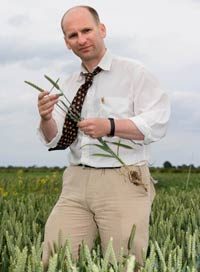TAG trials cutting energy use on farm

Increases in soil indices from the use of composts, limited success from legume cover crops, and yield increases via controlled traffic farming have been some of the initial findings of a long-term project, growers heard at The Arable Group‘s Morley open day.
The New Farming Systems project funded by the Morley Agricultural Foundation and the JC Mann Trust was looking at ways to reduce the environmental footprint of farming, TAG’s Ron Stobart explained.
To do that required a re-evaluation of current systems by improving both existing working practices and considering novel solutions. Three main strands were being researched: Fertility building, tillage systems and soil amendments, he said.
All three were being investigated to reduce the reliance on bagged N and lower fuel usage, which make up 75% of the energy use in producing a tonne of wheat.
Applying 35t/ha of compost was one of the methods being trialled to augment fertility and potentially reduce use of inorganic fertiliser. “We’re using green waste from Norwich – hedge clippings, grass cuttings, etc,” Mr Stobart said.
Increased moisture infiltration rates into the soil had been recorded during the first year of trials, when the compost was applied to winter wheat, he said. “We’ve also seen useful increases in soil indices, with average P levels going from a two to a three, K from a two minus to a two plus, and magnesium from a one to a two.”
Those increases were worthwhile, particularly with high inorganic prices for those nutrients, but only if the cost of haulage and spreading didn’t become prohibitive. “You probably don’t want to be hauling much more than 15-20 miles.”
Another part of the project, in collaboration with the University of Cranfield, had investigated the impact of compaction, but deliberating compacting plots compared with using a controlled traffic system. “There was a 1.75t/ha yield difference in the wheat plots.”
But implementing a controlled traffic system on farm can bring its own problems, he said, particularly at harvest. “So we’re looking at whether you use low ground pressure tyres at harvest, and then go back to CTF for the rest of the time. By doing that we got up to 75% of the yield response last year in some systems, but we need to see if that is stable over time.”
Another strand of the research was comparing the energy use from different cultivation systems. Preliminary analysis suggests that energy savings in cultivation of around two-thirds can be made from using shallow non-inversion tillage compared with the plough.
But when the total energy use for producing the crop was taken into account, initial estimates suggested that saving dropped to nearer 20%, he admitted.
“The biggest chunk of energy use is the fertiliser, which is why we are interested in fertility building. In one of our more extreme ideas, we’re looking at clover in the bottom of the canopy.”
Bi-cropping wheat with clover had been a mixed success, however, he said. “At Morley we saw an increase in fertile tiller numbers, but no yield response.”
That was on a high yield potential site, he noted. But in a similar trial at Cirencester funded by the John Oldacre Foundation where yield potential was lower, a 0.25t/ha response had been recorded.
Grassweed timing
Atlantis (mesosulfuron-methyl + iodosulfuron-methyl-sodium) timing should be moved forward to the 1-2 leaf stage rather than 2-3 leaf currently suggested by the product’s manufacturer, TAG’s Jim Orson said.
That had proved the best timing in the organisation’s trials, he said. “Bayer used Atlantis alone in its registration trials, but now we’re mixing it with a residual earlier applications are better. I’d advise spraying it as early as possible in the autumn within reason.”
The main problem with the timing was when there were other weeds for growers to control. “If you’ve got sterile brome the timing is probably OK, but it would be too early for meadow brome, for which a spring application is best. “It is also a little bit early for ryegrass, while for wild oats again you need to go in the spring.”
Fungicide mixtures key
Fungicide programmes incorporating lots of different modes of action will be the key to future disease control, according to TAG’s Stuart Knight.
“Mixtures are the right way to go. They minimise the risk of resistance developing to a particular group [of chemistry], you don’t need to second guess what disease will develop each season, and they deliver the best yield response.”
That approach would hold even when the new fungicides in development were approved, he said. “Those new fungicides are still at risk from resistance development – they’re not immune.”

